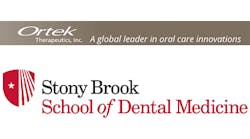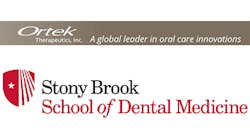With help of Stony Brook University, Ortek awarded patent for precavity detection device
New device relies on electrical properties of demineralized enamel
On Wednesday, Ortek Therapeutics Inc. (Roslyn Heights, New York) announced that it had been awarded a patent for the Ortek ECD dental device, a system for detecting early or precavity lesions that cannot be readily detected by visual examination or x-ray.
Human and laboratory clinical studies have demonstrated that the ECD device can detect the earliest stages of tooth demineralization or precavity lesions with 100% accuracy.
The ECD device is designed to detect precavity lesions in molars and premolars. The biting surfaces of these teeth have deep grooves that often retain acid-producing bacteria. Over time, acid attacks can lead to tooth mineral loss, which initiates the development of cavities.
Tooth enamel is electrically non-conductive unless breached by demineralization or fracture. When this occurs, dentinal fluid percolates through the breached enamel site and enables the battery-powered ECD to complete its electrical circuit.
RELATED: Ortek introduces BasicBites
The ECD device features a handpiece with a probe tip and can precisely measure the amount of dentinal fluid seepage. The more fluid it detects, the greater the extent of the precavity lesion. This data enables the dental practitioner to determine the severity of any lesions and design an appropriate treatment plan that could include minimally invasive care.
“We believe the ECD is a major breakthrough in oral care,” says Mitchell Goldberg, president of Ortek. “Dental professionals will soon have a new and valuable tool that will help their patients avoid cavities. We are now evaluating commercialization strategies and are pursuing US FDA and worldwide marketing clearances.”
US patent 9,277,875, “Device for the Detection of Non-Cavitated Early Dental Caries Lesions,” was issued to The Research Foundation for the State University of New York (Albany, NY). Its revolutionary technology was developed at Stony Brook University School of Dental Medicine.
Ortek has exclusive worldwide licensing rights to this patented technology. Patents covering this device have also been issued in Australia, China, and Mexico with other patents pending worldwide.
Through a strategic alliance with The Research Foundation of State University of New York, Ortek has developed major scientific breakthroughs in oral and cutaneous microbiome technology. The company has developed and commercialized revolutionary technology for dental cavity prevention, detection, and treatments for dentinal sensitivity. The company's core oral microbiome AlkaGen Technology, which is contained in its proprietary BasicBites soft chew confections, is based on the scientific expertise of researchers in the Department of Oral Biology and Pathology at Stony Brook University School of Dental Medicine.
—Ortek Therapeutics Inc. press release 16 March 2016
YOU MIGHT ALSO LIKE:Stony Brook University's "Discover Dental School: Summer Scholars Program"


